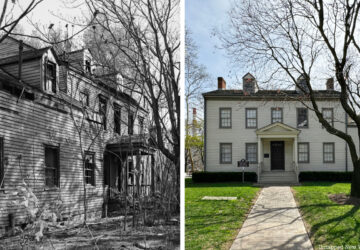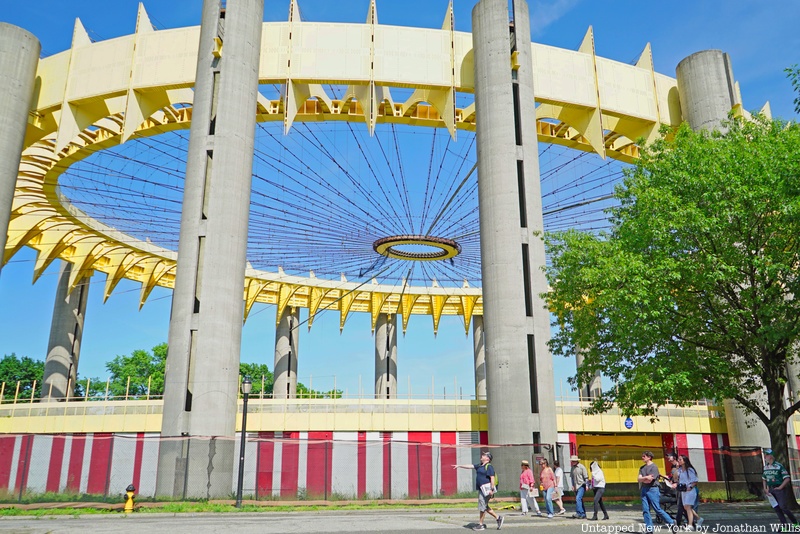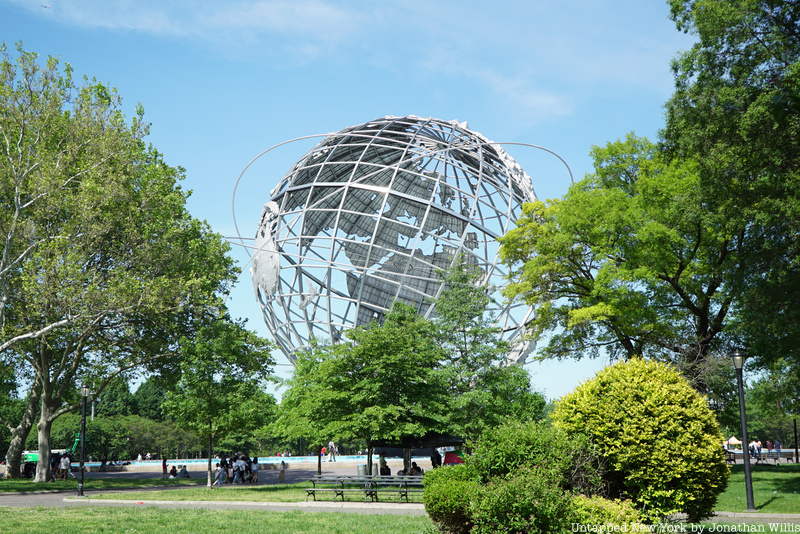When a World’s Fair comes to town, it leaves a lasting mark. New York City has hosted multiple World’s Fairs, from America’s first in 1853 to the World’s Fairs of 1939-40 and 1964-65 at Flushing Meadows-Corona Park. While the Crystal Palace and Latting Observatory from the first fair at the site of Bryant Park are long gone, many relics of the Queens fairs remain. Here, we take a look at some of the remnants of the 1964 World’s Fair that you can still see today!
Visit remnants of the World’s Fair on a special Untapped New York Insiders tour to commemorate the fair’s 60th anniversary on April 21st!
This tour, led by Untapped New York’s Chief Experience Officer Justin Rivers and Artist-in-Residence Aaron Asis, will visit sites not shown our regular Remnants of the World’s Fair walking tour and include behind-the-scenes access to the Queens Theatre! Guests will also hear from a variety of special guests from People for the Pavilion and the New York State Pavilion Paint Project, who have been integral in the preservation of World’s Fair remnants. This tour is free for Untapped New York Insiders! Registration for tickets opens on April 7th at 12pm ET.
1. The Tent of Tomorrow
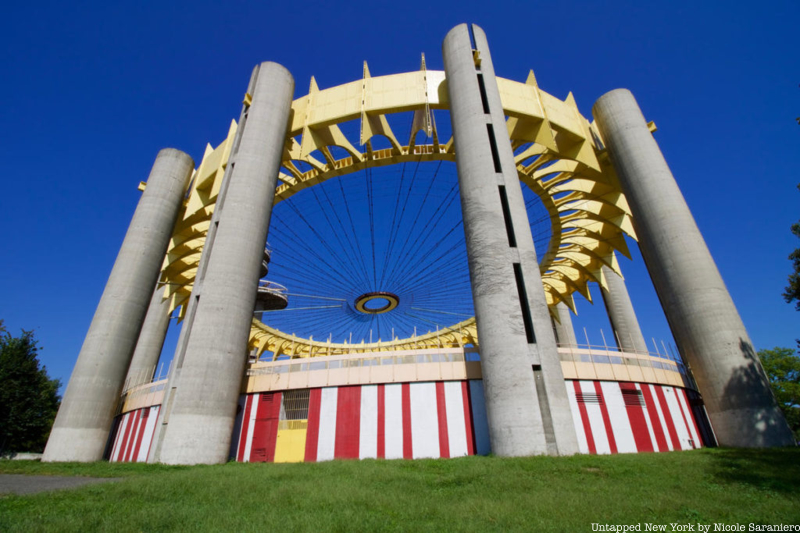
“Man’s Achievement on a Shrinking Globe in an Expanding Universe” was the theme of the 1964 World’s Fair and the New York State Pavilion embodied that theme in the modern design of its buildings. One of those buildings that still stands today is The Tent of Tomorrow, designed by noted architect Philip Johnson. The circular structure once boasted the world’s largest cable suspension roof (50,000 square feet) which supported a dazzling display of multi-colored fiberglass tiles. On the floor, there was a massive 567-panel terrazzo road map of the state of New York.
Most buildings constructed for World’s Fairs are demolished once the fair closes. Constructed according to lenient building codes, the buildings weren’t intended for future use. Demolition was often the most economical option. When the 1964 World’s Fair closed, the fate of the New York State Pavilion was in limbo. Robert Moses and other New York City officials wanted to see the Pavilion stay as a permanent feature of the park. In letters and other primary documents from 1963 to 1968 discovered in the Rockefeller Archive Center by People for the Pavilion, you can see the debate unfold. Eventually, ownership of the Pavilion was transferred to the City of New York, and the Tent of Tomorrow was preserved.
When the fair ended, the Tent of Tomorrow was converted into an outdoor concert venue and briefly served as a roller skating rink before closing in 1974. For decades after, the Pavilion sat abandoned and deteriorating. The roof is completely gone and there are just a few small pieces left of the terrazzo map. Today, the structure is currently the subject of a $24 million restoration project that began in 2019 and is set to finish later in 2023. The scope of the project includes extensive preservation work in addition to the cosmetic enhancement of dynamic architectural lighting. This project is the first major effort to restore the site since it was abandoned.
2. Column of Jerash
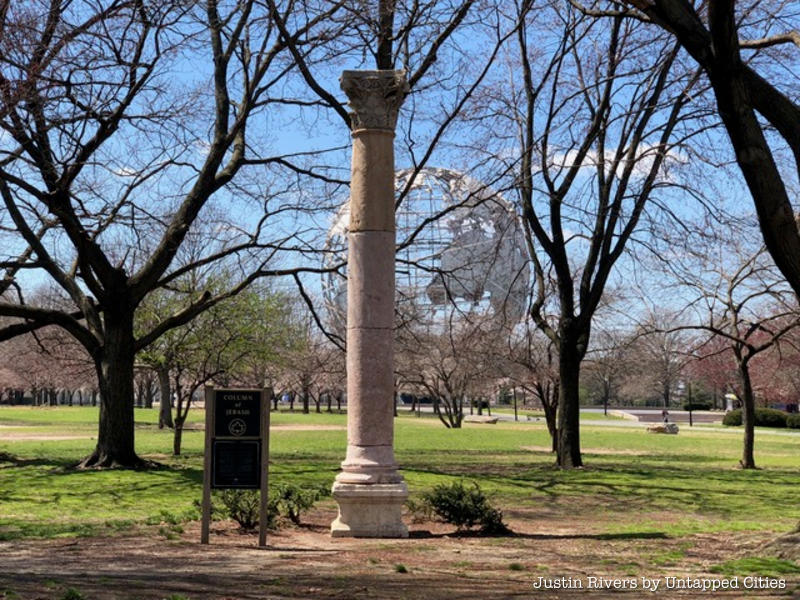
The second oldest man-made object in New York City, after Cleopatra’s needle in Central Park, is a remnant of the 1964 World’s Fair. That object is the Column of Jerash, a 30-foot-tall Roman column dating back to the year 120 AD. The column was presented to the New York World’s Fair Corporation and the City of New York by King Hussein of the Hashemite Kingdom of Jordan. It was originally erected by Romans in the Jordanian city of Jerash, or Gerasa, as it was known then.
At the fair, the column stood as part of the Jordanian exhibit, which was described as a “multi-peaked-and domed structure with an undulating roof, and surfaced in gold mosaic and shimmering blue glass.” Inside there were religious and historical artifacts, including the Dome of the Rock, statues of the Three Kings, and a Dead Sea Scroll displayed in a replica of a cave. Today, the marble Column of Jerash can be found east of the Unisphere.
3. The New York Hall of Science
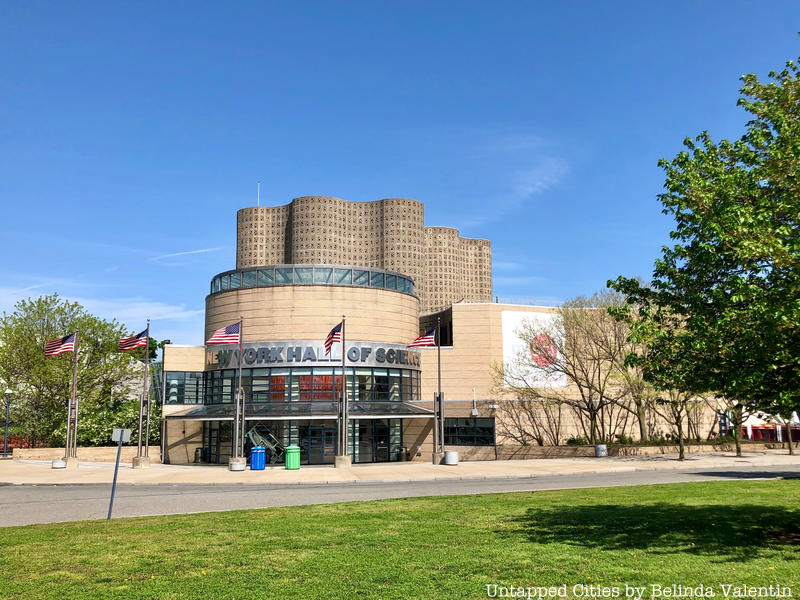
One of the rare World’s Fair structures built as a permanent fixture was the New York Museum of Science and Technology, designed by Wallace K. Harrison (the same architect who led the design of the United Nations and Metropolitan Oprea House at Lincoln Center). The standout feature of the design is the Great Hall, a 90-foot-high tower made of more than 5,000 concrete dalle-de-verre panels. Dalle-de-verre is a French term that means “slab of glass” and refers to the result of embedding colored glass pieces in concrete, as seen with the blue glass tiles and concrete at the Hall of Science. The effect of light streaming through these cobalt fragments is meant “to evoke the feeling of journeying through the cosmos.” Today, the building is known as the New York Hall of Science (NYSCI) and serves as a museum and research center that supports STEM education.
4. Flushing Meadows Carousel
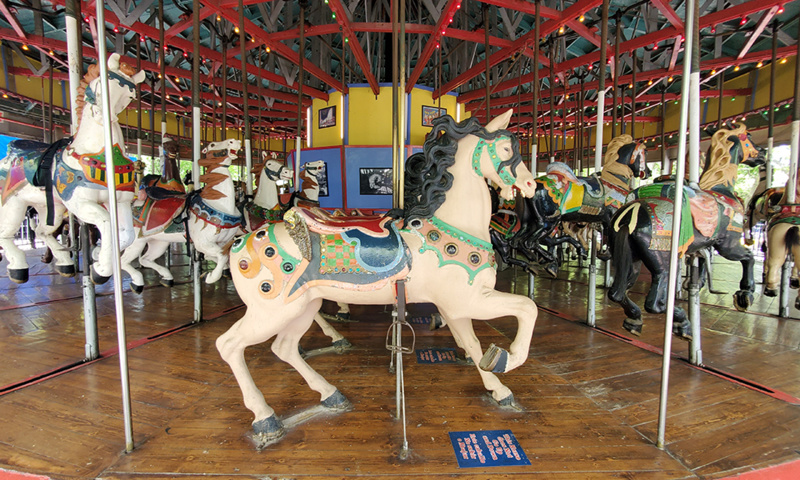
Just a ten-minute walk from NYSCI you’ll find another World’s Fair remnant, the Flushing Meadows Carousel. This merry-go-round was crafted out of two older carousels from Coney Island: Feltman’s Carousel and the Stubman Carousel. Master carousel maker Marcus Charles Illions hand-carved the wooden figures that circled Feltman’s. It was completed in 1903. A New York Times article that marked its 1964 closing reported that in its 61 years in service, “President William Howard Taft, Diamond Jim Brady, soldiers and sailors, Ziegfeld girls, and countless children” rode it.
The wooden figures were held in a warehouse before being bought by a New York lawyer who had ridden the carousel as a child. Looking for a way to save the attraction, he reached out to Robert Moses. A spot was made for the carousel on the fairgrounds. The hybrid carousel from the World’s Fair still runs today. Riders have their choice of over 70 figures including 64 jumping horses, 7 standing horses, 1 menagerie animal, and 2 chariots.
5. Street Names
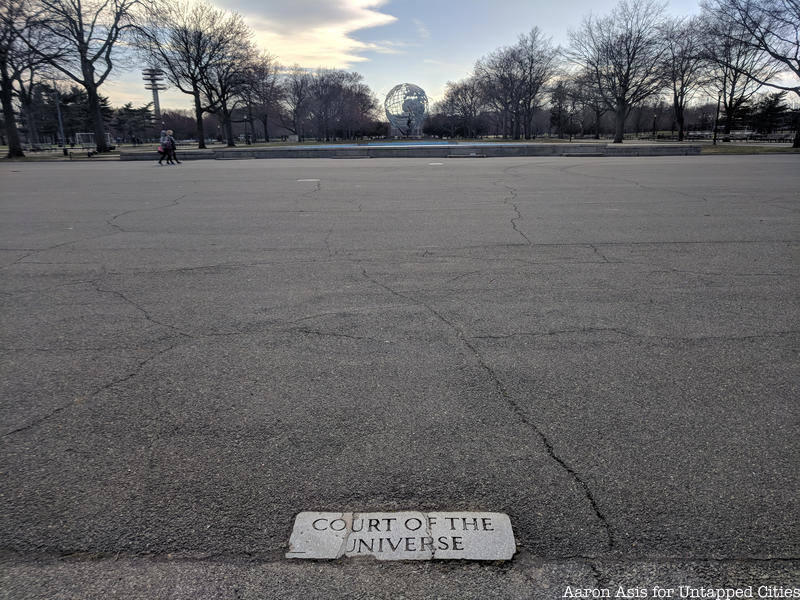
Though the radial street grid of the park was laid out for the 1939-40 World’s Fair, the street names we see today are from the 1964-45 Fair. The Trylon and Perisphere served as the focal point of the radial grid in 1939, replaced by the Unisphere in 1964. You can still see street markers that bear names like “Court of the Universe,” “Avenue of Science,” and “Astronaut Court,” which fit in with the fair’s theme of “Peace through understanding in a shrinking globe and in an expanding universe.”
6. Panorama of the City of New York
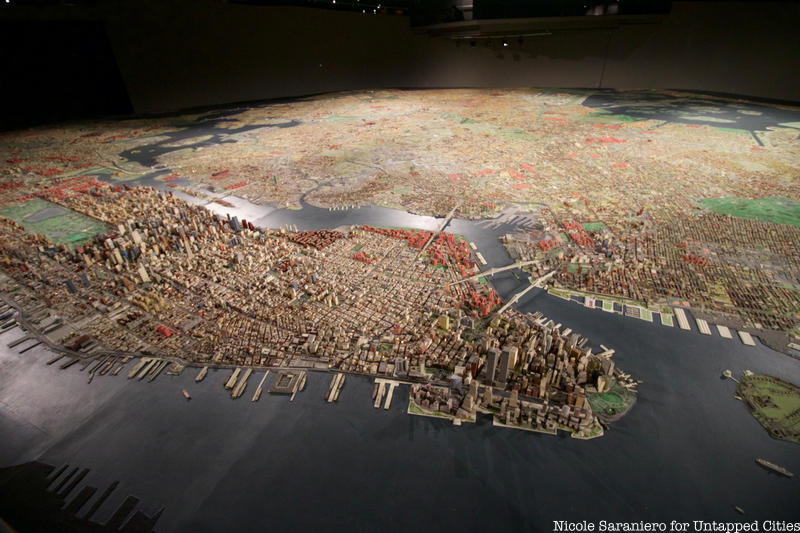
The Panorama of the City of New York was commissioned by Robert Moses for the 1964 World’s Fair and was originally a ride. During the fair, visitors to the exhibit would board a mini helicopter car and “fly” above the panorama for a 9-minute tour of the 9,335-square-foot architectural model. The model features over 895,000 plastic and hand-painting wooden structures originally created over the course of three years by a team of 100 craftsmen from Raymond Lester & Associates. The tiny replicas represented every building in the five boroughs constructed prior to 1992. You can also see every street, every park, and 100 bridges.
The Panorama ride operated for about four years after the fair. The model was updated a few times, largely by donations from architects and developers including Emery Roth and Sons. A major restoration project was undertaken by Raymond Lester & Associates in 1992 to update the model. The most recent buildings and places to be added since then include Citi Field, Yankee Stadium, Brooklyn Bridge Park, Newtown Creek Wastewater Treatment Plant, and 27 buildings in Battery Park City. The Panorama became a permanent exhibit in the Queens Museum in 1972. Today, visitors don’t fly above the floor anymore but instead walk around the display on see-through balconies. Every hour you’ll experience a simulated sunrise and the model goes into a glowing night mode. You can even own a piece of the Panorama through the museum’s Adopt-a-Building program launched in 2009 as a creative way to raise funds for its care and maintenance.
7. Space Park
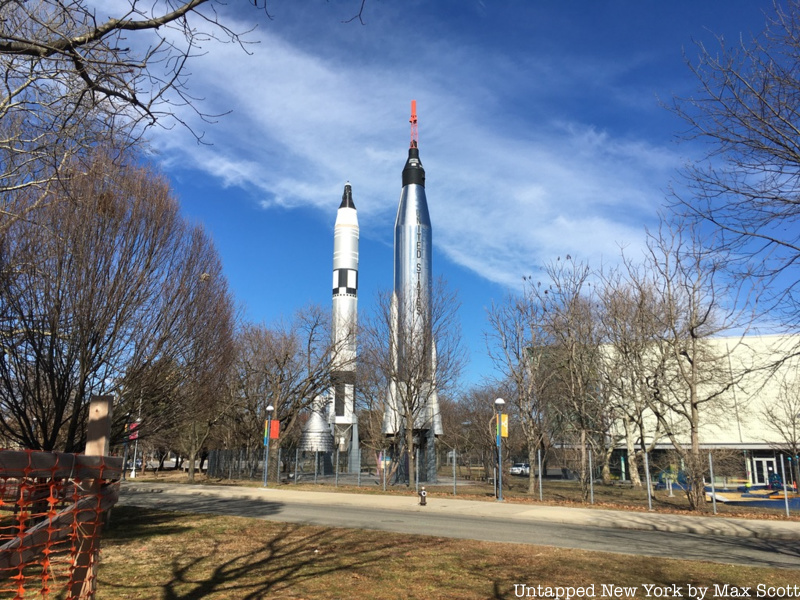
On a visit to the Hall of Science (also a remnant of the 1964 World’s Fair), you might see the tip of a rocket peeking above the trees. These space age relics are holdovers from the United States Space Park, an attraction created by NASA and the Department of Defense for the 1964 World’s Fair. The fair took place in the middle of the Space Race, so people were excited to see these vessels in person.
The two-acre park featured pieces of both the Mercury and Gemini space flight programs, including the “boattail” or propulsion section of the massive Saturn V rocket (the rocket that would eventually take astronauts to the moon), a Project Mercury spacecraft that had orbited the Earth, a model of the Apollo, a full-scale X-15 rocket-powered research airplane, and two giant rockets. The exact rockets that remain in the park today never traveled toward space, but were originally made for the Air Force in 1961 to carry nuclear warheads.
Like many remnants of the 1964 World’s Fair, the Space Park fell into disrepair. In 2001, the rockets were shipped to Akron, Ohio, to be restored by Thomarios®, a firm that has worked on rocket repairs for the Kennedy Space Center and the Smithsonian Institution. They were reinstalled in 2003 with a ceremony attended by Walter Cronkite and astronaut Ellen Baker. In 2010, a nine-hole mini-golf course was installed at the park which sits near the Hall of Science.
8. A Time Capsule
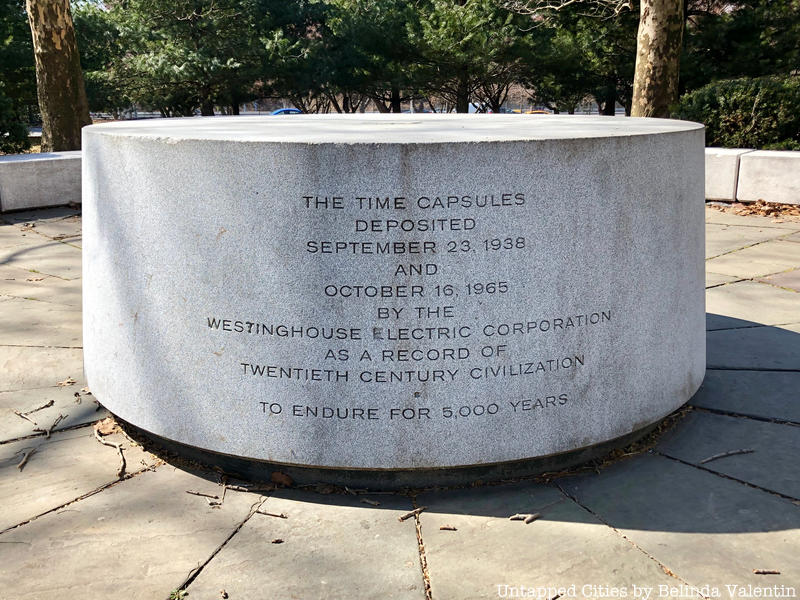
There are two time capsules buried deep beneath Flushing Meadows-corona Park. Originally created by Westinghouse Electric & Manufacturing Company for the 1939-1940 World’s Fair, the first capsule was an impressive feat of engineering. The objects were housed in a seven-foot tall, 800-pound metallic cylinder shell made out of a state-of-the-art metal alloy of copper and chromium, called Cupaloy. This alloy is highly resistant to corrosion and engineers believed that it would withstand the forces of nature for 5000 years.
On October 10, 1965 a second capsule containing items reflective of life at the time was buried alongside the original 1939 capsule. Items in the 1964 version include credit cards, contact lenses, an electric toothbrush, antibiotics, synthetic fiber, and of course, a Beatles record.
9. The Observation Towers
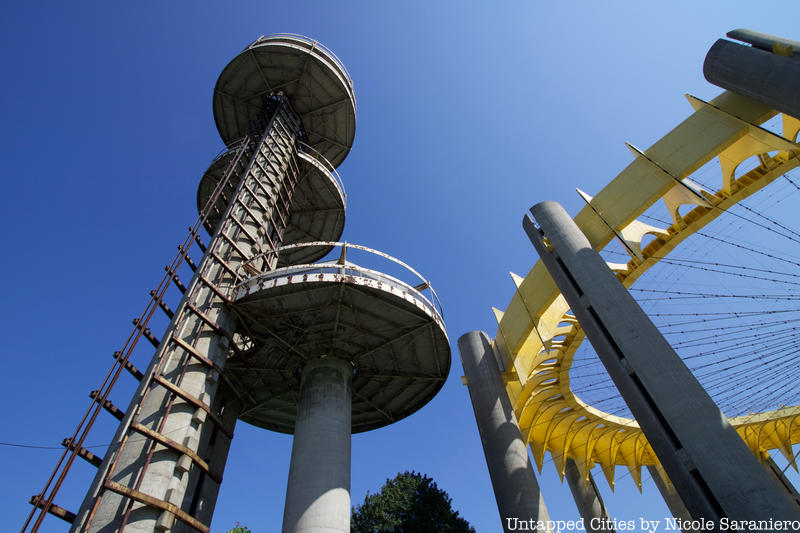
Three concrete Observation Towers were another part of the New York State Pavilion. During the fair, the tallest tower, which was also the tallest point in the fair at 226 feet, served as an observation deck. It was accessed by the “Sky Streak capsule,” an elevator that took guests to the top for a magnificent view of New York City. The two shorter towers housed cafeterias.
Abandoned after the fair, the Towers had a starring role in the 1997 film Men in Black. The structures will be getting some love in the current restoration project as workers waterproof the tower bases, replace stairs, conduct electrical upgrades, and perform structural conservation work.
10. The Unisphere
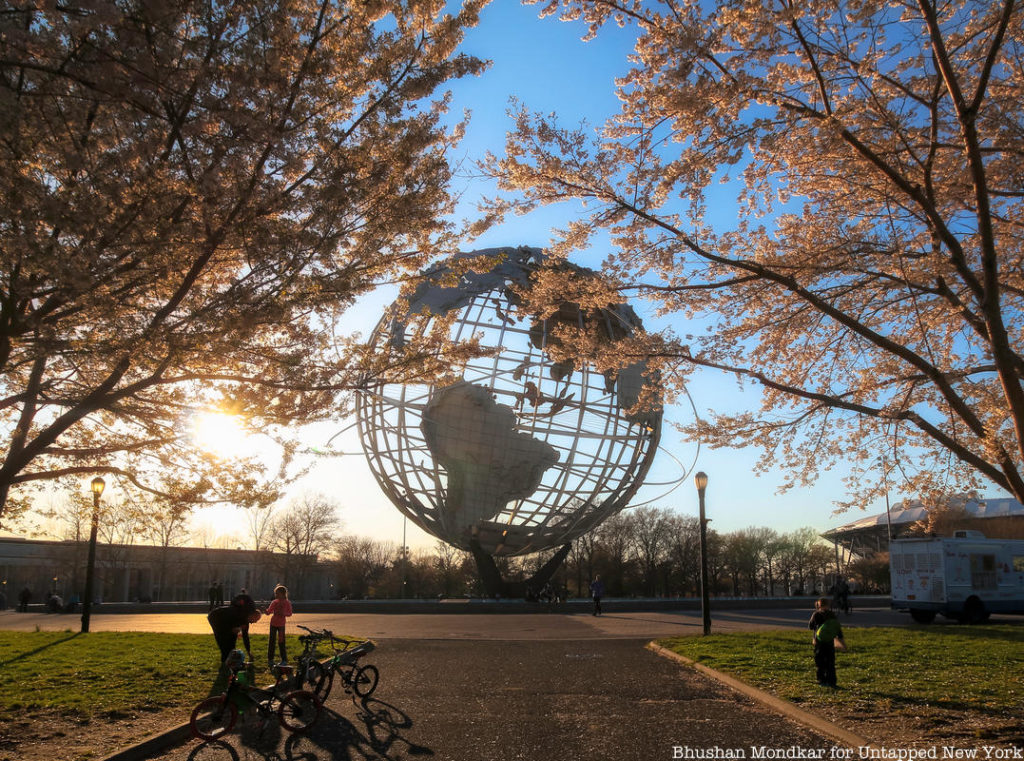
One of the most recognizable remnants of the 1964 World’s Fair is the Unisphere. Created as the centerpiece of the fair, it stands at the same spot where the 1939 Fair’s Trylon and Perisphere once stood, at the center of the radial street plan of the fairgrounds. The giant globe holds the title of being the largest representation of Earth on Earth!
The Unisphere was designed by landscape architect Gilmore D. Clarke. It is made of 350 tons of stainless steel and measures 120 feet in diameter. Capital cities of the world are marked by lights on the stainless steel structure and mountain ranges are shown in relief. Circling the globe are three orbital rings that represent the path of early satellites.
11. Terrace on the Park
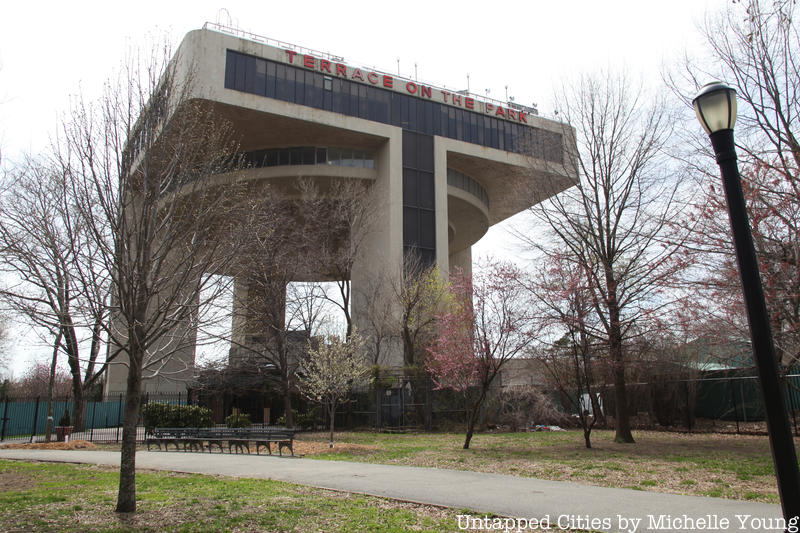
Terrace on the Park, now a private catering hall for weddings and events, was originally a heliport commissioned by The Port Authority of New York. The 120-foot high “aerial gateway” stood in the Transportation Area, which its “T” shape represents. It was designed by architect Gordon Lorimer with engineers John Kyle and Ray Monte, and planning chief E. Donald Mills.
Known as The Port Authority Heliport and Exhibit Building during the fair, the building featured a 1,100-seat Top of the Fair restaurant from which diners could enjoy an impressive view. On the floors below the restaurant, visitors could sip cocktails at the Drinks Around the World cocktail lounge featuring beverages from 24 locations around the globe. Those actually interested in transportation could enjoy a twelve-minute film about the amenities of the Port of New York and New Jersey on a 360-degree screen.
12. The Rocket Thrower
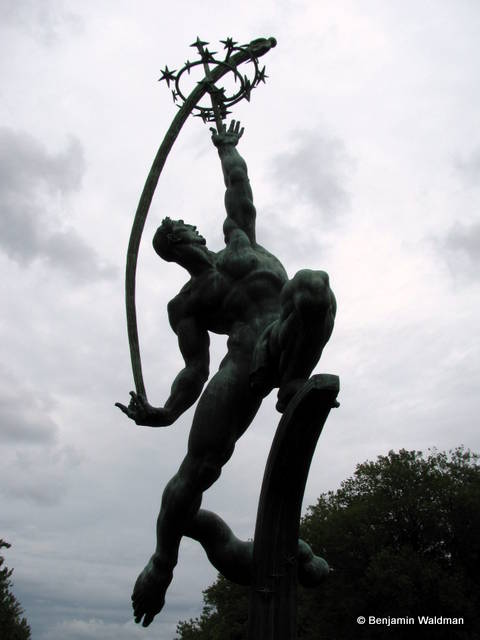
Sculpture Donald DeLue had only six months to create The Rocket Thrower after petitioning Robert Moses for a commission at the 1964 World’s Fair. The sculpture, which can be found between the Pool of Reflections and the Unisphere, measures 43 feet tall and depicts a bronze figure hurling a rocket toward the heavens with his right hand. With his left hand, the subject is reaching for a constellation of gilded stars.
This sculpture was based on another idea DeLue had for a commission at the Union Carbide Building (270 Park Avenue) entitled Man Conquering Space. The sculpture symbolized “man’s relationship to space and his venturesome spirit backed up by all the powers of his intelligence for the exploration of a new dimension.”The Rocket Thrower debuted on April 22, 1964, shortly before the fair opened.
13. Theaterama
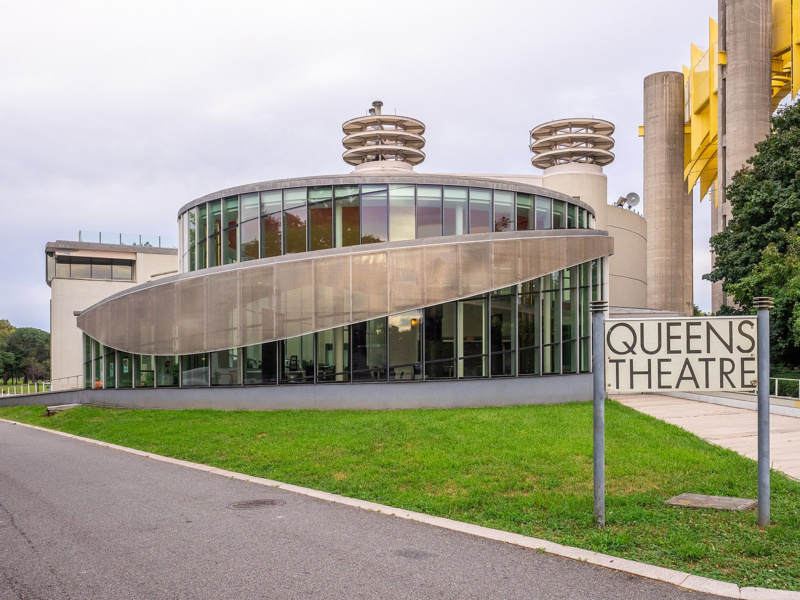
Another piece of the New York State Pavilion that exists as a remnant of the 1964 World’s Fair is Theaterama, now the Queens Theatre. During the fair, the Philip JOhnson-designed theater showed a 360-degree panoramic film on the State of New York. The exterior facade was used as a sort of gallery wall to display large-scale original art by famous pop artists such as Andy Warhol, Roy Lichtenstein, Robert Rauschenberg, and Ellsworth Kelly.
In 1972, the theater was converted from a movie house to a live theater space. Queens Theatre was officially established in 1989 and in 1993, after a $4 million renovation, the theatre finally opened with a gala event.
Gain special access to the theater on our upcoming 60th Anniversary World’s Fair tour!
Uncover more remnants of the 1964 World’s Fair and the 1939 World’s Fair on our upcoming walking tour of Flushing Meadows-Corona Park!
Next, check out 10 Remants of the 1939 World’s Fair
